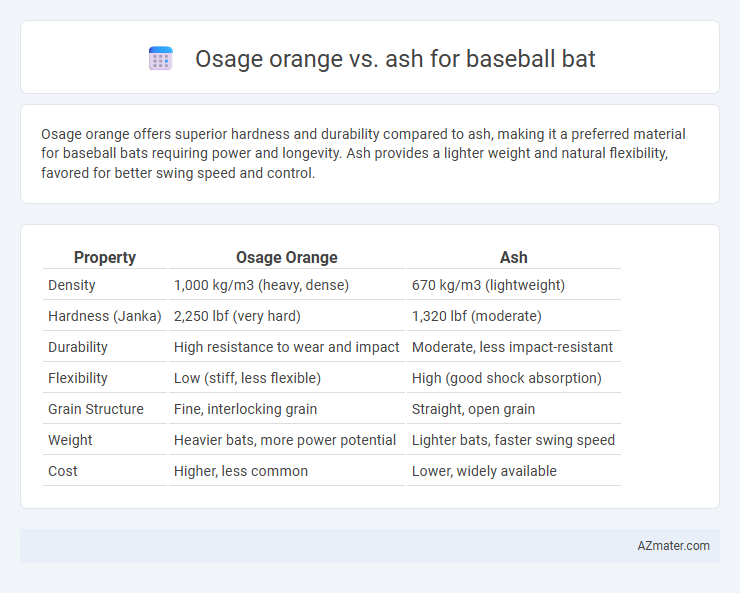Osage orange offers superior hardness and durability compared to ash, making it a preferred material for baseball bats requiring power and longevity. Ash provides a lighter weight and natural flexibility, favored for better swing speed and control.
Table of Comparison
| Property | Osage Orange | Ash |
|---|---|---|
| Density | 1,000 kg/m3 (heavy, dense) | 670 kg/m3 (lightweight) |
| Hardness (Janka) | 2,250 lbf (very hard) | 1,320 lbf (moderate) |
| Durability | High resistance to wear and impact | Moderate, less impact-resistant |
| Flexibility | Low (stiff, less flexible) | High (good shock absorption) |
| Grain Structure | Fine, interlocking grain | Straight, open grain |
| Weight | Heavier bats, more power potential | Lighter bats, faster swing speed |
| Cost | Higher, less common | Lower, widely available |
Introduction to Osage Orange and Ash as Bat Materials
Osage orange, known for its extreme hardness and dense grain, offers exceptional durability and powerful hitting performance for baseball bats, making it a favored choice among players seeking strength and resilience. Ash wood, praised for its lightweight flexibility and balanced stiffness, provides excellent shock absorption and swing speed, often preferred for its traditional feel and enhanced control. Both materials present distinct advantages in bat manufacturing, with Osage orange emphasizing strength and longevity, while ash prioritizes maneuverability and comfort during play.
Historical Use of Osage Orange and Ash in Baseball Bats
Osage orange has a long history in baseball due to its exceptional hardness and durability, favored for its resistance to wear and resistance to splitting. Ash became the traditional wood choice for baseball bats in the early 20th century, prized for its light weight and flexible grain, which offers a larger sweet spot and better swing speed. While ash remains the dominant material in professional leagues, Osage orange bats are still appreciated by enthusiasts for their unique strength and historical significance in woodcrafting.
Wood Density: Osage Orange vs Ash
Osage Orange wood boasts a high density of approximately 56 lbs/ft3, making it significantly denser than Ash, which has a density around 37 lbs/ft3. This increased density in Osage Orange translates to greater durability and power transfer when used for baseball bats. Ash, being lighter, offers enhanced swing speed and control but may sacrifice some impact strength compared to the denser Osage Orange.
Durability and Strength Comparison
Osage orange offers exceptional durability and strength, known for its dense, hard grain that provides excellent resistance to cracking and wear, making it ideal for high-impact baseball bats. Ash wood is lighter and more flexible, offering a good balance of strength and shock absorption, but it is generally less durable than Osage orange under repeated heavy use. The superior hardness and weight of Osage orange contribute to longer-lasting performance and increased power in swings compared to the more traditional ash bats.
Flexibility and Performance on the Field
Osage orange offers superior stiffness and impact resistance compared to ash, delivering exceptional durability and power for baseball bats. Ash provides greater flexibility and a lighter feel, allowing for faster swing speeds and improved control during play. Choosing between Osage orange and ash depends on whether a player prioritizes maximum strength or enhanced swing flexibility for on-field performance.
Grain Structure and Its Impact on Bat Quality
Osage orange features a dense, interlocking grain structure that provides exceptional hardness and durability, making it highly resistant to cracking and ideal for high-quality baseball bats. Ash has a straighter, more open grain that offers lightweight flexibility and better shock absorption but tends to be less durable under repeated high-impact use. The grain structure in Osage orange enhances bat longevity and power transfer, while ash prioritizes bat control and comfort.
Weight and Balance Differences
Osage orange baseball bats are notably denser and heavier than ash bats, offering increased durability and power but requiring more strength to swing effectively. Ash bats provide a lighter feel with superior flexibility and a balanced swing weight, promoting quicker bat speed and better control. The weight distribution in osage orange tends to be more concentrated towards the barrel, while ash bats often feature a more balanced or handle-heavy profile, impacting swing mechanics and player preference.
Cost and Availability of Osage Orange and Ash
Osage orange baseball bats typically command higher prices due to the wood's rarity and slower growth rate compared to ash, which is more abundant and widely harvested for sports equipment. Availability of Osage orange is limited, making the supply inconsistent, whereas ash is readily accessible from sustainable forests, ensuring steady supply and lower cost. The cost advantage and widespread availability of ash make it a popular choice for budget-conscious players and manufacturers.
Player Preferences: Pros and Cons
Osage orange bats are favored by players for their exceptional hardness and durability, offering powerful hits and less risk of splintering, though they can be heavier and less forgiving on swing speed compared to ash bats. Ash bats remain popular due to their lightweight nature and flexible grain structure, providing faster swings and better shock absorption, but they tend to dent or crack more easily under heavy use. Player preferences often hinge on balancing the need for strength and longevity with swing speed and comfort, making Osage orange ideal for power hitters, while ash suits players prioritizing quicker swings and control.
Conclusion: Choosing the Right Wood for Your Bat
Osage orange offers exceptional hardness and durability, making it ideal for players seeking a bat with a powerful hitting surface and long lifespan. Ash provides a lighter weight and greater flexibility, enhancing bat speed and control for those who prioritize swing comfort and quickness. Selecting between Osage orange and ash depends on whether you value maximum durability or a balanced combination of weight and swing speed for optimal performance.

Infographic: Osage orange vs Ash for Baseball bat
 azmater.com
azmater.com